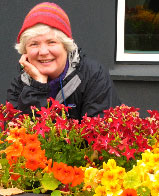Closing the Loop
And if we keep on pumping it out,
where to put the excess CO2? Tucked
into the bottom of lens lakes on volcanic shoulders,
it forms its own gaseous layer
till some deadly belch sends it spilling down
the slopes, a silent suffocating flood
that drops oxygen-breathers dead in its tracks.
So no injecting lakes with CO2.
The ocean? Here the question is what can live
in water turned acidic—whatever it is,
it won’t be the coral reefs, flora, or fish
of the oceans that we know. So no.
Pumped into rock? What would acid water dissolve
and leach into our water tables? What sinkholes
open up, swallow our houses?
The soil? Salted with composted
concrete dust, the fields of corn and soybean
could pump CO2 to roots, the roots to soil,
where it would bind with calcium to make
a pebble-coating calcium carbonate—good for a while,
until the fields seize up like rock.
So back to what we know: the trees. Make
new plantings, mixed, with seeds of local rainforest relics
where slash and burn has left companionate microfungal net;
move northern hardwoods to their new ranges,
multiply shaders of city sidewalks and parking lots,
fill nurseries with species waiting to colonize
the tundra as it unfreezes, populate the permafrost,
the arctic islands under glaciers now—and keep
them watered. The U.N. target this year, one billion
trees planted—new brooms to sweep the skies
clean of what we can’t stop burning.
—Robin Chapman, Madison, WI


